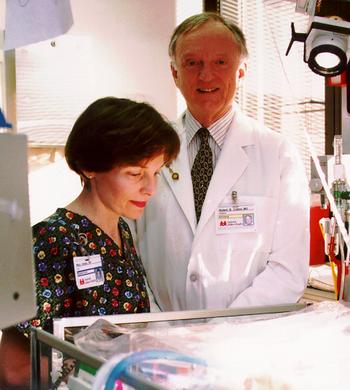Researchers battle lung disorder that strikes premature babies

Dr. Robert Cotton in the NICU with Nurse Mary Green. (Photo by Donna Jones Bailey)
The good news in neonatology is that more and more babies being born early are surviving with fewer neurologic problems than in the past.
But the price many of those babies pay for their survival is a bout with a form of chronic lung disease, one that Vanderbilt Children's Hospital researchers are working to better understand, treat and hopefully prevent.
"Fifteen or 20 years ago, we didn't see much of this," said Dr. Robert B. Cotton, professor of Pediatrics and director of the Specialized Center in Newborn Lung Disease.
"An optimist might say that it's good news that we're seeing more of this disease because it means more premature babies are surviving, but we're not happy to stop there.
"This condition is limiting ‹ although we anticipate that the babies, for the most part, will be able to grow new lung tissue. But we still don't know the extent to which they may have pulmonary problems into childhood, even into adulthood, as a result of this experience at birth.
"The long-lasting effects are as yet unevaluated because the explosion of new survivors at the lowest gestational ages has not been going on long enough for the babies to have reached their teens and young adulthood."
The chronic lung disease is called bronchopulmonary dysplasia (BPD) and is characterized by dependence on mechanical ventilation for weeks, months or even longer, Cotton said. It results when an infant is born with severely immature lungs that aren't ready yet for normal breathing, when these lungs receive some sort of injury and when something goes awry in the repair of that injury.
Injuries that can lead to BPD include airway infection, trauma during ventilation, and hyaline membrane disease, a lung disease which itself lasts only a few days.
Another significant source of injury is exposure to oxygen, specifically the single-atom form called oxygen free radicals. Oxygen injury to the lungs is the area of focus for Cotton and his colleagues, whose research bridges the span from laboratory bench to patient bedside.
Among their exciting discoveries:
€ The observation that a particular enzyme, a member of the so-called p450 enzyme system, is elevated in newborn lambs' lungs when the lambs are exposed to oxygen. This enzyme, in turn, produces free radicals as a by-product.
"So here's oxygen as a bad culprit to begin with and then exposure to oxygen turns on this enzyme that makes matters even worse," Cotton said.
The finding was made by Dr. Thomas A. Hazinski, professor of Pediatrics, and researchers in his laboratory. They were then able to reduce oxygen toxicity in the lambs by giving them a drug, cimetidine, that inhibits the enzyme.
This work led Hazinski and Cotton to collaborate on a clinical trial testing whether p450 inhibitors can reduce oxygen injury to the lungs of newborn babies.
The first phase of the trial testing cimetidine showed that that particular inhibitor did not produce a similar result in the humans. However, the researchers were not particularly disappointed in that finding, Cotton said, because lambs and humans are so different. There are several p450 inhibitors available, and the evidence is strong enough in the animal studies to suggest that another drug may work where cimetidine did not, he said.
€ The identification of a predictor for whether premature babies develop chronic lung disease, a marker for oxygen injury called F2 isoprostanes.
F2 isoprostanes, a form of prostaglandin, were identified as a novel product of lipid oxidation by two other Vanderbilt University Medical Center researchers, Dr. Jason D. Morrow, associate professor of Medicine and Pharmacology, and Dr. L. Jackson Roberts, professor of Pharmacology and Medicine.
"As part of our clinical study, we measured the level of F2 isoprostanes in tracheal-bronchial aspirate fluid in premature infants," Cotton said. "We found that the levels on the very first day after birth can predict whether they will have chronic lung disease, as assessed weeks later at 36 weeks post-conceptual age."
That finding provides a means of identifying ‹ virtually at birth ‹ which babies are most likely to develop BPD. Down the road, if a p450 inhibitor or other treatment is identified that can prevent or reduce oxygen injury to the lung, this finding would be important to identify babies for early treatment.
€ The discovery that the p450 enzyme inhibitor cimetidine, when given to the newborn lambs, also appeared to reduce the levels of a compound called epoxides ‹ yet another product of p450 enzymes and another potential culprit in lung injury.
Epoxides have a variety of biologic functions, including inflammatory actions such as increasing permeability of the capillaries, attracting white cells and dilating the blood vessels. Such inflammatory responses also can contribute to lung injury.
"So this may be a double whammy," Cotton said. "You expose the newborn to oxygen, and this enzyme system is turned on, which produces free radicals, and it also produces epoxides, which cause more damage."
The newborn lambs not treated with cimetidine had "sky-high" levels of epoxides, while the treated lambs had lower levels, Cotton said.
"This gives us circumstantial evidence implicating another mechanism by which oxygen exposure might be causing lung damage," Cotton said. "We've now learned that in the premature infants exposed to oxygen, just as in the lambs, the levels of epoxides are elevated in the lung.
"This is a novel finding that gives us another lead to follow in understanding the development of chronic lung disease. It also suggests that a strategy to inhibit p450 might be beneficial.
"All we've got to do now is find the right p450 inhibitor."













